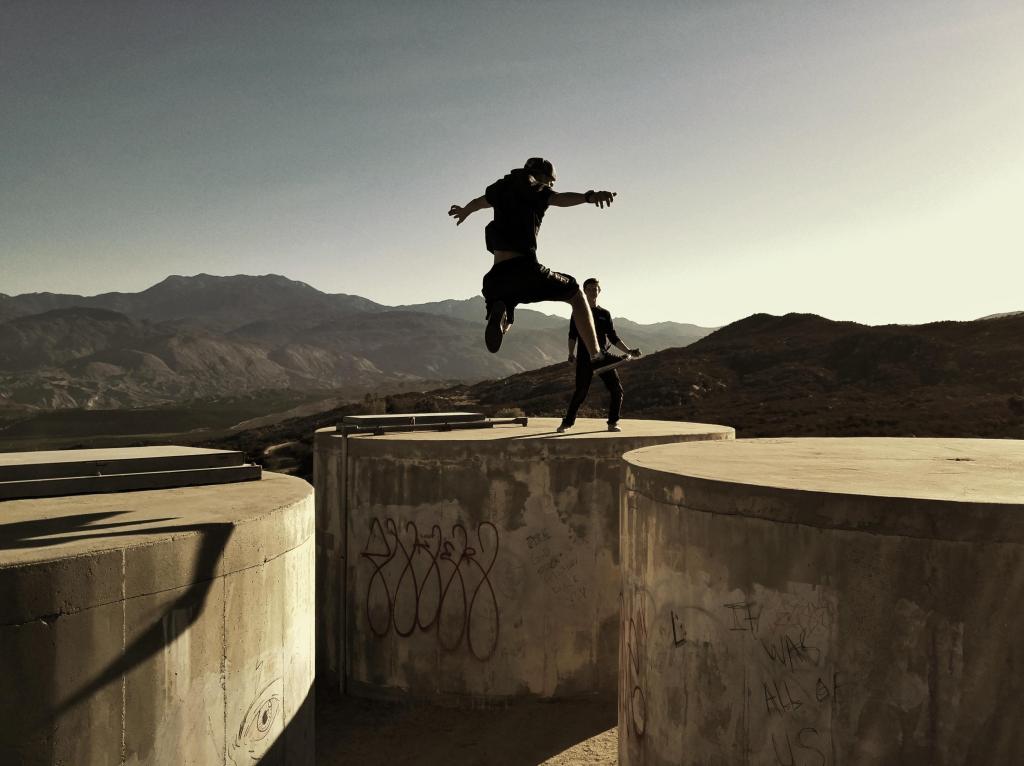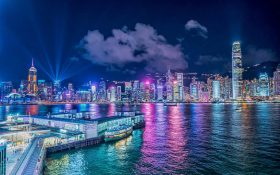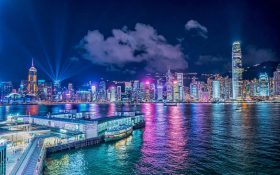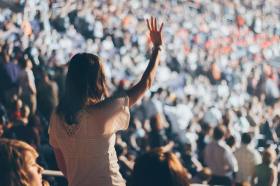What do performing artists need to create their best work, and what can organizations do to support them? At HERE, the twenty-five-year-old multi-disciplinary performing arts organization located in lower Manhattan, New York, which I as Founding Artistic Director co-lead with Executive Director Kim Whitener, we recently completed a three-year pilot project, expanding our existing artist residency program with specific technical, spatial, and staffing resources, in order to explore this question. We are excited to share our discoveries about the impact of these resources on the creative process, to suggest new ways to craft a meaningful artist-led developmental/premiere process, and to reveal the benefits the field might garner from revising standard practices.
For close to twenty years, HERE’s signature program and the backbone of our season has been the HERE Artist Residency Program (HARP). This nationally recognized multi-year residency program provides an artist (or team of artists) with commissioning funds, fees for workshops and developmental activities, space, equipment, in-kind services, project development support, career planning, and a full production, all within a collaborative environment of peers. The program stands out because it serves mid-career artists working across artistic disciplines, including theatre, dance, music, puppetry, visual art, and new media. Each two- to three-year residency is tailored to the needs of each resident artist.
Thanks to a three-year grant from The Katherine S. and Axel G. Rosin Fund of The Scherman Foundation, we were able to expand our existing comprehensive residency program by testing a radical re-imagining of the use of our space, equipment, and staff. This test provided our resident artists and their collaborators with dedicated use of our well-equipped theatre spaces for “design residencies”—week-long technical experimentation workshops during key developmental phases—and extended technical rehearsals prior to the artists’ premieres. In the design residencies, the artists and design teams had the unusual opportunity to try out ideas without the pressure of public performance, with access to the equipment and technical staff, and in the space in which they would later premiere their work. Our objective was to encourage creative risk-taking. Our artists found these experiences to be transformative.
In order to track the impact of these resources, we asked each Resident Artist and their collaborators to fill out questionnaires after they completed a design residency, after each of their workshop presentations, and after their full production. Upon completion of the three-year test, we conducted individual post-mortem meetings as well as two roundtable discussions with sixteen lead artists and designers. Artists were invited to share their experiences with this pilot program, speak candidly about their ideal creative process—including how the resources offered impact them and what they might like to have that wasn’t offered—and make recommendations for the field.
Our artists felt, unsurprisingly, that given sufficient time, money, and resources, they had greater freedom to experiment with an unfamiliar technique, to try and fail at something, and to reach for the more difficult but perhaps more compelling artistic choice. In the words of one director: “The number of workshops represent the number of risks you can take.” Our artists uniformly agreed that this risk-taking led to richer and more nuanced creations.
Ultimately, the feedback throughout the three-year test, further affirmed by the artists’ discussion during the postmortems, gave our organization a more accurate and complete understanding of what artists who blur the boundaries of performance in genres and forms need to succeed. This has resulted in a shift in the way we configure our resources in order to ensure the creation of more fully imagined and seamlessly integrated works. Our artist residency program now includes design residencies and extended tech rehearsal time as well as our previously established set of resources: artist creative retreats, public in-progress showings, early dramaturgical involvement of artistic collaborators, extended community engagement practices, and compensation. Our productions culminate in limited run engagements in a ninety-nine-seat theatre with budgets ranging from US $100,000 to US $175,000 in cash and US $50,000 in in-kind services. We believe that others operating within a similar scale in the field, especially those working across disciplines and media formats, may benefit from the elements we utilize to support our artists’ visions.
Retreats
Artists felt that in a long-term developmental process, out-of-town artist retreats for concept and script development were indispensable to their creative process. The dedicated time to generate material and focus on the shape of the work, and the peer conversations each evening, were both beneficial for the artists. Retreats of one to three weeks in length are recommended. Artists have told us that they’ve achieved more in a week on retreat than they would in a month at home.
In-Progress Showings
Typically, our artists created two to three public workshop showings over their process, while taking time between each draft to process and revise. The time in-between allowed for the opportunity to take a step back and look at how the show was working, formulate changes both conceptually and concretely, and then activate those changes. Some artists worked on small sections while others tackled a full draft of the whole work for each showing.
Each workshop was off-book and fully staged with meaningful tech time. Artists agreed that workshops improved the quality of their work and were efficient, saving time and money, since they could try something on a smaller scale and realize it wasn’t right before committing to a full version.
Dramaturgical Process
Integrating designers and/or other collaborators, including performers, throughout the process was deemed essential. Artists found that tandem development of design and script through frequent dramaturgical and storyboarding sessions made for a richer, more fruitful process. A clear sense of the capacity of the project in terms of money, equipment, and time from the very beginning was also important to designers, as it enabled them to design to the appropriate scale, to create with vision while within limits.
A designer told us that being involved with script development “created a strong sense of team, a strong morale, and allowed for a different lens on the work.”
Rehearsal Resources
In order to craft the strongest work in rehearsals, our artists were most concerned about space, time, and collaborator involvement:
Space
Artists required a dedicated, secure space with a comparable floor plan to the actual performance space with sufficient sound, video, and/or lighting equipment to replicate the elements that were integral to their creative process. It was also really important to their creative flow to not lose valuable time and energy with setting up and breaking down a rehearsal room daily.
Time
Two to three weeks of rehearsal for workshop showings were much more impactful to the projects’ growth than five-day workshops. Many artists also agreed that a six-week rehearsal process for a premiere would be enough to develop and refine the overall arc, and smooth out transitions between sections. Ideally, three of those rehearsal weeks would be in the theatre in which they were performing. One director posited that rehearsals could be shortened if actors came to the first rehearsal off-book, like opera singers and a number of European theatre practitioners.
Collaborators
Creators were eager to have their design collaborators more present in rehearsals, and there was a hunger for the opportunity to engage in design conversations as they are creating. At the same time, the artists acknowledged that it is possible to have designers involved too early. Designers suggested that attending rehearsals would be most productive with design conversations built into the process: it was helpful for them to see the process, but not be buried in it the whole time. Costume designers suggested that wardrobe support be considered for rehearsals to allow for costumes to be worked with.
A director noted that, “Even when the script was in flux, and designers weren’t producing something technical, being in the room earlier allowed them to contribute dramaturgically, which was freeing and helped inform design choices later.”
Design Residencies
Design residencies—one- to three-week-long design workshops in the performance space in which the piece would premiere, with the actual equipment and tech staff—were incredibly rewarding and invaluable to the artists’ process. Without the pressure of public performance at the end of the workshop, artists have the freedom to play and not be precious about the end product. Many felt six months before premiere was the ideal time, deep enough in the process to really understand how the design would be integrated into the show; early enough to uncover new solutions. In general, earlier deadlines and decisions made for better-informed design choices. For lighting designers to be as well-served, it was essential to devote sufficient investment in installing a show-specific light plot. The budget for these residencies needed to include appropriate fees for performers, designers, and technicians. We also learned that some artists were more adept than others at planning their residencies, and that our artists benefited from conversations on how best to utilize these residencies with our artistic leadership. Since design residencies aren’t a common practice, the conversations helped the artists understand the range of resources and strategy that worked for others.
Extended Tech Time
For our artists, both in theory and in practice, having extra time for technical rehearsals transformed a show. They unanimously agreed that one week of tech was tight, whereas adding an extra few days or a full week shifted the creative process to allow for experimentation, a deeper collaborative process, and an opportunity to fully integrate the elements.
A choreographer told us that this “was the first time in my professional life where the tech time allotted felt sufficient, even generous. This created a relaxed focus that extended through the run.”
Storage
The simple inclusion of storage space in developmental planning offered significant benefits to our artists. Having a secure place for props, scenic items, technical gear, and costume racks transformed their rehearsals. Similarly, a plan for storage of all of the above between developmental iterations was also an essential, but often overlooked, resource.
Community Engagement
We have found that developing relationships with communities over time (instead of waiting until the premiere) grew committed audiences for our artists’ unusual work. We invited audiences into conversation with both the work and the artist in a variety of ways throughout the development process: to experience each stage of development (open rehearsals, work in progress, and workshops) and offer feedback; to participate in talks on the subject matter; and to have more intimate dialogue with the artist(s). This built substantial community investment, strong word-of-mouth, and increased audience enthusiasm once we got to the premiere.
Compensation
Artists wanted to be paid appropriately for the time they actually spent on each project. A number of artists found it useful to break their fee into hourly or weekly chunks, to better gauge how much they were actually being paid to create the work. Extended workshop and design residencies meant more time for collaborators, and appropriately translated into higher compensation. Artists felt strongly that designers in different disciplines need varying lengths of time to create for the same show, simply due to the unique demands and complexity within each project, but our typical industry practices do not currently acknowledge the disparity.
Transparency
Transparency across the board is empowering. Artists and producers need to talk more openly about getting paid. Artists were hungry for transparency: they wanted access to the whole budget and to see how they individually fit into the whole picture. As one director put it, “When no one knows what anyone else is making, everyone is ashamed and everyone lacks agency.”
Is Favored Nations the right system?
Artists felt that it is not one-size-fits-all for all collaborators on each project, especially for designers in different disciplines. The organization/producer needs to really look at each position and assess scale on each specific project. There is an assumptive hierarchy relating to compensation, materials, and labor budgets that needs to be dismantled. The artist fee and the support for the implementation need to be considered as separate items.
A designer pointed out that “determining pay scales has a lot to do with hourly expectations: can I work on other stuff this week or just this project? Am I putting my full brain and time into this process both inside and outside of rehearsals? Or am I just stepping in, being present for part of the day, and able to take on other work too?”
Fees and Support for Designers
In some cases, an appropriate budget for assistants, materials, and labor can make lower fees more acceptable. Video designers suggested having one fee for projection design and a second one for content creation. They also suggested adding a budget line for licensing and weekly subscriptions into all budgets with video. Costume designers wanted support that is equivalent to the other departments, with a costume construction budget in addition to wardrobe supervision. Lighting and sound designers suggested adding separate fees for revising design and paperwork for shows to tour to different venues as opposed to just being paid royalties.
For a two- to three-year development process with multiple in-progress showings and design residencies prior to a premiere, creators believed that US $20,000-$25,000 would represent a fair living wage, and designers agreed US $10,000-$15,000 meant they could be fully present and engaged in the work. Our artists suggested an appropriate rate of US $200 a day, and US $1,500 a week.
Conclusion
For twenty-five years, HERE has remained an innovative leader in how to develop and produce art for new generations by remaining flexible and adaptive. In response to challenges voiced by our resident artists, we adjust our commissioning, development, and production approaches in HARP. As a fertile “arts incubator,” we support each artist’s singular vision by putting them in control of their work, providing them with access to resources, and fostering dynamic collaboration among a cohort of artists and their enthusiastic audiences. Through this comprehensive support, our artists are freed to usher in a new age of artistic collaboration as they create innovative groundbreaking work of the highest standard.
Appendix
The following appendices are included as a demonstration of the principles behind the HERE Artist Residency Program in order to offer greater insight on the process described above and provide a model for other arts service providers and producers:
– Values for Artists to Create Their Best Work
– Tools for Creating Excellent Work
– Developmental/Producing Project Timeline
***
Contributions made by Wei-ming Liu Egelman, Brenna Thomas, and Kim Whitener.
***
This piece, A Blueprint for Risk-Taking by Kristin Marting, was originally published on HowlRound on 8 March 2018.





